小学英语各单元知识点总结word版本
(完整word版)外研版小学英语语法总复习知识点归纳

(完整word版)外研版小学英语语法总复习知识点归纳外研版小学英语语法总复知识点归纳一、时态1.一般现在时(1)表示经常发生的动作或事情,通常用“usually通常,often常常,every…每…。
sometimes有时,always总是,”等词。
(2)基本结构:主语I / You / We / They /He / She / It肯定句:主语+动词原形或动词第三人称单数形式否定句:主语+don’t + 动词原形或者doesn’t + 动原一般疑问句(Yes/No) Do…。
Yes。
I do.No,I don’t.Does…(动词原形)…?Yes,he/she does。
No,he/she doesn’t.特殊疑问句What do …。
How does she…(动词原形)…?(3)动词第三人称单数方式(同名词单数酿成复数办法不异)1.普通情形+s如:walk-walks2.辅音字母+y结尾去y +ies fly-flies3.结尾是s。
x,sh。
ch +es watch-watches4.结尾是0 +es do-does。
go-goes5.特殊have-has2.现在进行时(1)表示正在发生的动作,通常用“now现在。
look看,XXX听”.(2)根本方式: be +动词-ingeg: I am(not) XXX.You/We/They are(not) reading。
He/She/It is(not) eating.What are you doing。
Is he reading?(3)动词的目前分词方式(动词+ing)普通情形+ing walk—walking末端是不发音的e-e+ingcome—coming重读闭音节双写末了一个字母+ingswim-swimming。
run-running3.一般过去时(1)表示过去已经发生的事情,通常用“last …上一个…。
just now刚才,many years ago许多年前,XXX昨天”等词。
江苏译林版小学英语六年级上册知识点整理(Word版,28页)
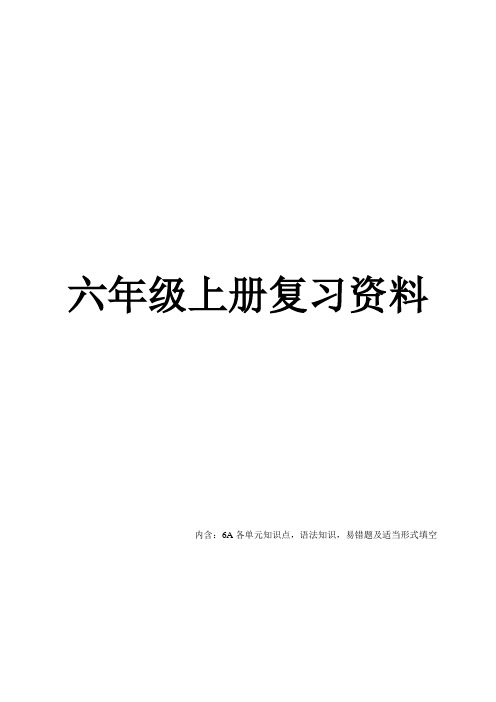
六年级上册复习资料内含:6A各单元知识点,语法知识,易错题及适当形式填空6A Unit 1 The king’s new clothes姓名:一,单词/词组1. long long ago 很久以前2. new clothes 新衣服3. make new clothes for you 为你制作新衣服 make sth for sb4. show the king his new clothes给皇帝展示新衣服show sb. sth.= show sth. to sb.5. try on 试穿try on the coat=try the coat ontry it/them on6. magic clothes 有魔力的衣服7. walk through步行穿过 8. in his new clothes 穿着他的新衣服9. shout at sb. 对某人大叫10. laugh at sb. 对某人大笑11. look at 看….12. point at 指向…13. fit well 非常适合14. an American cowboy 一个美国牛仔15. a Scottish man 一位苏格兰人16. tell a story 讲一个故事17. say a/one sentence 说一句话18. on the mountain 在山上19. the next sentence 下一句话20. live in the house 住在房子里21. tell the boy a story 给这个男孩讲一个故事 tell sb. sth.22. it is one’s turn 某人的机会23. think hard 努力思考24. have to 不得不 have to do sth.25. in front of 在….前面(外部) in the front of 在… 前面(内部)26. walk by 路过27. be nice to sb. 对某人好28. look after 照顾29. turn into 变成二,句型1. Long long ago, there was a king. 很久很久以前,有一位国王。
(完整版)小学英语知识大全
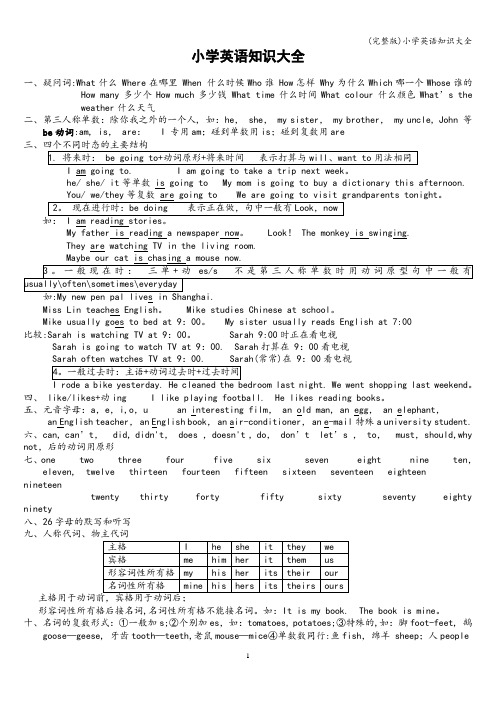
小学英语知识大全一、疑问词:What什么 Where在哪里 When 什么时候Who谁 How怎样 Why为什么Which哪一个Whose谁的How many多少个How much多少钱 What time什么时间What colour什么颜色What’s theweather什么天气二、第三人称单数:除你我之外的一个人, 如:he, she, my sister, my brother, my uncle, John 等be动词:am, is, are: I 专用am;碰到单数用is;碰到复数用areI am going to. I am going to take a trip next weekhe/ she/ it等单数 is going to My mom is going to buy a dictionary this afternoon.。
I am reading storiesMy father is reading a newspaper now。
Look! The monkey is swinging.They are watching TV in the living room.:My new pen pal lives in Shanghai.Miss Lin teaches English。
Mike studies Chinese at school。
Mike usually goes to bed at 9:00。
My sister usually reads English at 7:00比较:Sarah is watching TV at 9:00。
Sarah 9:00时正在看电视Sarah is going to watch TV at 9:00. Sarah打算在 9:00看电视常常)在 9:00看电视。
四、 like/likes+动ing I like playing football. He likes reading books。
冀教版小学三年级英语上册3-4单元单词总结word版
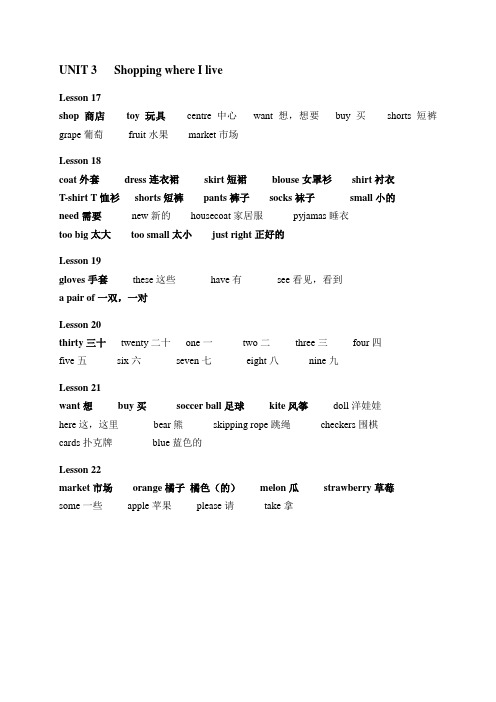
UNIT 3 Shopping where I liveLesson 17shop商店toy玩具centre中心want想,想要buy买shorts短裤grape葡萄fruit水果market市场Lesson 18coat外套dress连衣裙skirt短裙blouse女罩衫shirt衬衣T-shirt T恤衫shorts短裤pants裤子socks袜子small小的need需要new新的housecoat家居服pyjamas睡衣too big太大too small太小just right正好的Lesson 19gloves手套these这些have有see看见,看到a pair of一双,一对Lesson 20thirty三十twenty二十one一two二three三four四five五six六seven七eight八nine九Lesson 21want想buy买soccer ball足球kite风筝doll洋娃娃here这,这里bear熊skipping rope跳绳checkers围棋cards扑克牌blue蓝色的Lesson 22market市场orange橘子橘色(的)melon瓜strawberry草莓some一些apple苹果please请take拿UNIT 4 Healthy me!Lesson 25hungry饿的thirsty渴的drink喝eat吃like喜欢melon瓜something一些东西strawberry草莓Lesson 26run跑swim游泳play soccer踢足球skip跳(绳)fly飞ride骑health健康bicycle自行车kite风筝rope粗绳Lesson 27friend朋友broken坏的use用,使用sure当然draw画good好的some一些be careful小心please请Lesson 28play玩park公园ball球catch接住,抓住high高的sky天空rest休息sit down坐下read读,阅读Lesson 29scarf围巾hat帽子boots靴子sweater毛线衣wear穿Lesson 30listen to听sing唱gym体育馆write写work工作our我们的us我们sport运动Lesson 31phone电话computer电脑TV电视put away收拾,整理watch TV看电视love爱evening晚上talk说话supper晚餐later较晚的,过后say说其中黑体字的单词为必会单词。
(完整word版)小学英语必背单词及短语句型

第三册要点bag 包 bed 床 beef 牛肉 book boy 男孩bread 面包brother 兄弟chair 椅子chicken 肉 classroom教室desk 桌doctor 医生friend 朋友girl 女孩home 家milk 牛奶mother pen 笔pencil 笔fishrice 米room 房ruler 尺子school 学校sister 姐妹student 学生teacher 教water 水window 窗nurse 士第四册要点computer 算机board 写字板fan 扇 light 灯this 个is 是my 我的that 那个your 你的 picture 画wall 壁floor 地板yes 是的 it 它 one 一two 二three 三 four 四five 五six 六seven 七eight 八nine 九 ten 十what 什么time it ’s=it i s 它是 o’clock 点⋯ math 数学Chinese 文English 英P.E. 体育music 音for ;class 程red 色的 blue 色的 yellow 黄色的green 色的 white 白色的no 不;不是not 不是的skirt 短裙shirt 衫 jacket 克衫T-shirt T 恤衫 dress衣裙 colour 色 warm 温暖的 cold 严寒的cool 凉快的 today 今日 jeans 牛仔 pantssocks 袜子shoes 鞋子 let ’ s我 play 玩,踢football 足球 snowy 下雪的sunny 明朗的 how much 多少 big 大的 small 小的 long 的short 短的banana香蕉pear 梨orange橙子watermelon 西瓜are 是(复数 ) they 它(他,她) horsearen ’不t是 (复数 ) cat 猫rabbit 兔子pig 猪 duck 子dog 狗 eleven 十一twelve 十二thirteen 十三 fifteen 十五 twenty 二十 how many 多少 there 那边 /里第五册要点smart 明的 old 年迈的 thin 瘦的 funny 风趣可笑的 tall 高的 active 活的but 可是 quiet 寂静 ;娴静的 very 很;特别 young 年 strong 壮的 kind 和切的 Mr. 先生 short 矮的 like 像;喜strict 格的 who’s=who is是 what ’s=what 是is什么 he’s=he 他is是she ’ s=she她is是 Monday 礼拜一 Tuesday 礼拜二 Wednesday礼拜三Thursday 礼拜四 . Friday 礼拜五Saturday礼拜六Sunday 礼拜天day 天;日子 have 有 ;吃on 在⋯⋯候 too 太;也grape 葡萄don’ t=do not不要 fruit 水果 salty 咸的 fresh 新的 .favourite 最喜的tasty 好吃的 fish茄子.sour 酸的we 我 lunch 午 ;中餐tomato 西柿potato 土豆tofu 豆腐green beans 青豆they ’ re=theyare 他 (她 ;它 ) 是 .curtain 窗帘trash bin 垃圾桶closet 衣橱 .mirror 子end table 床柜bedroom 寝室.kitchen 厨房 bathroom 生living room 客in 在⋯中/里on 在⋯上 under 在⋯下 near在⋯邻近 behind 在⋯后边 clothe 衣服river 河流flower 花grass草lake 湖泊 forest 丛林 pat 小道park 公园house房屋bridge tree 木 road 路;公路building 建筑物 clean 干的eggplant 茄子sweet 甜的第六册要点Apr. 四月 at 在⋯点Aug. 八月because 因best 最;极birthday 诞辰 date 日期 Dec. 十二月evening 夜晚 ;夜晚fall 秋季Feb. 二月flygrandpa;外公 her 她的 Jan. 一月July 七月June 六月May 五月 Mar. 三月 noon 正午 Nov.十一月 Oct. 十月often常season 季Sept. 九月 skate 溜冰 sleep 睡sometimes有候spring 春季 summer 夏季 swim 游泳 uncle 叔叔usually 往常 ; 一般why 什么weekend 周末which 哪一个winter 冬季honey 蜂蜜 study 房jump 跳 run 跑 kangaro 袋鼠climb 往上爬fight 打斗 swing ;秋千第七册要点:by ;乘⋯foot 脚 bike 自行 bus 公共汽 train 火how 怎 traffic 交通 stop 停;停站wait 等;等候 library post office 局 hospital 医院cinema 影院bookstore 店where 哪里 pleaseturn 弯right 右 left 左straight 成直地 then 而后 comic book 漫画 post card 明信片newspaperbuyhobby 好dive 跳水 live 居住 teach教go 去 watch 看read ;看 does 助 doesn’t否认助singer 歌唱家writer 作家 actor 男演actress 女演 artist 画家TV reporter 台者engineer 工程accountant 会policeman 警察 salesperson 售cleaner 清工work 工作rain 雨;下雨 cloud 云;云彩 sun 太阳 stream小溪;小河 seed 种子soil 泥土sprout 苗;嫩芽 plant 植物;栽种should 应当then 而后第八册要点单词taller 更高的shorter 更矮的 stronger 更强健的older 年龄更大younger 更年青的 bigger 更大的heavier 更重的longer 更长的thinner 更瘦的 smaller 更小的hurt 痛苦:受伤 matter 事情sore 疼的 nose 鼻子 tired 疲惫的excited 喜悦的 angry 生气的happy 快乐的 bored 无聊的 sad 悲伤的 last 上一个;最后的weekend 周末 to 向:朝 park 公园 Chinese 汉语 ;中国的good 好的 present礼品 boat 小船elephant大象how 如何;多么watch-watched观看wash-washed洗clean-cleaned 打扫play-played 玩 visit-visited 探望 ;拜见;观光 do-did 做 go-went 去 read-read 读:阅读learn-learned 学习dance- danced跳舞eat-ate吃take-took 照;拍climb-climbed 爬have-had 有buy-bought 买row-rowed 划see-saw看见leave-left 走开get-got 抵达三至六年要点短English teacher英老math teacher数学老Chinese teacher文老have( an )English class上(一 )英on Wednesdays在礼拜三do my homework 造作w atch TV 看play computer games玩算机游my favourite 我最的sweep the floor地 cook the meals(cook dinner)做read books看clean the room清房water the flowers 花wash the clothes洗衣服set the table餐具make the bed床do the dishes 洗碗碟 go to bed 上床睡 clean the bedroom 清寝室use a computer 用算机 near the table 桌子旁 under the bed 床下over the river 河上方on the desk桌上 in the closet 衣橱里behind the door 后边 a picture of my room 一我房的照片 taller than比⋯⋯高 have a fever have a (bad) cold( 重 )感冒 have a toothache牙疼 have a headache 疼 have a sore throat 喉疼 watch TV 看 wash clothes 洗衣服 play football 踢足球visit grandparents 探望祖父亲母亲go to a park 去公园go fishing 去go swimming 去游泳went hiking 去足learn Chinese 学sing and dance 唱歌跳舞 eat good food 吃美食 take pictures 照相buy presents 礼品 row a boat划船go to see elephant去看大象go skiing 去滑雪go ice-skating 去溜冰 read a book(read books)看do morning exercises晨 eat breakfast/lunch/dinner吃早 /中/晚fly kites 放筝get up 起床 go hiking 去足climb mountains(climb a mountain)登山climb trees 爬go shopping 购物 make a snowman堆雪人 play sports 进行体育运动play the piano弹钢琴 play the violin 拉小提琴 visit grandparents探望祖父亲母亲 draw pictures 画画 answer the phone接电话 listen to music 听音乐write a letter 写信 write an e-mail 写电子邮件 write a report 写报告 drink water 喝水 watch( count)insects 察看 (数)昆虫 take pictures照相 catch butterflies 捉蝴蝶 come/be from 来自 play chess 下棋collect leaves/stamps采集树叶 /集邮 do an experiment做实验on foot 走路 by train 坐火车 by bus 坐公共汽车by bike 骑自行车by plane 坐飞机stop at a red right红灯停make kites制作风筝wait at a yellow light 黄灯等 go at a green light绿灯 traffic light 交通灯near the post office邮局邻近 next to the hospital医院近邻get to 抵达turn left/ right 左/右转go/walk straight 直走get on/off 上/下车take a trip 去旅游go to the cinema看电teach English教英语影next week 下周ride a bike 骑自行车read newspapers看报纸live in Beijing 住在北京watch TV at night 夜晚看电视read a magazine看杂志 go to work 上班plant flower seeds 栽花种plant trees种树pick up leaves采摘树叶put away the clothes(整理衣服 ) empty the trash(倒垃圾 ) wake up(醒来 )do housework(做家务 )take off(脱掉 ) put on(穿上 ) hang up(挂起 )疑问词what(什么 ) which( 哪一个 ) when(什么时候 ) where(在哪里 )why(为何 ) how(如何,如何 )how many(多少 ) how much(多少钱 )what about(⋯⋯⋯怎么)what time(几点)的写I ’m = I amit ’s = it ishe’s = he ishe’s = she isthat ’ s = thatwhois’ s = who iswhat ’ s = what theyis ’ re = they are isn ’ t = is notaren ’ t = are notcan ’ t = cannotdon’ t = do not doesn ’ t = does notlet ’ s = let usI’ d=I would I ’ ll=I will第四册句型This is my computer. 这是我的计算机。
新版PEP小学英语 各册黑体单词及常用表达Word 文档
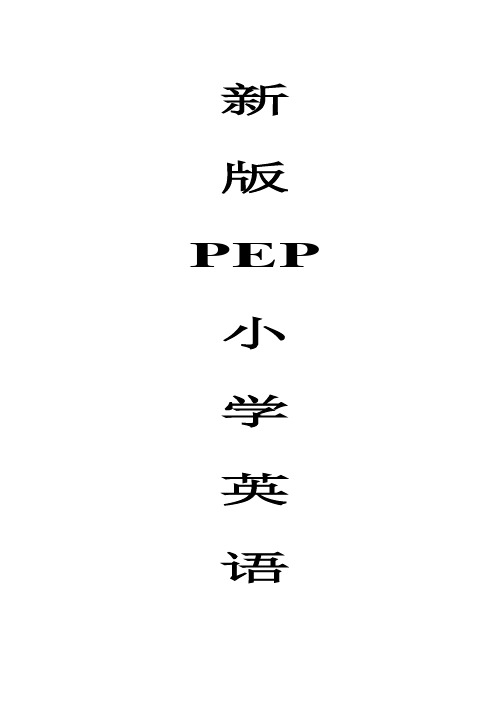
新版PEP 小学英语【单词】文具ruler(尺) pencil (铅笔) eraser(橡皮) crayon(蜡笔) bag (书包)pen (钢笔) pencil box ( 铅笔盒) book (书)【句子】1、 Hello, I’m Wu Yifan. 你好,我是吴一凡。
2、Hi, I’m Sarah. 你好,我是萨拉3、I have a ruler / an eraser.我有一把尺子/一块橡皮。
4、-What’s your name ? 你叫什么名字?-My name’s John. 我叫约翰。
5、-Goodbye! 再见!-Bye, Miss White. 再见,怀特小姐。
【单词】颜色red(红色的)green(绿色的) yellow(黄色的)blue(蓝色的) black(黑色的) brown (棕色的) white (白色的) orange (橙色的)【句子】1、--Mr Jones, this is Miss Green.琼斯先生,这是格林小姐。
-Good morning, Miss Green.早上好,格林小姐。
2、I see red.我看见红色。
3、Good afternoon, Wu Yifan.下午好,吴一凡。
4、-Nice to meet you.见到你很高兴。
-Nice to meet you, too.见到你也很高兴。
5、 Colour it brown!把它涂成棕色吧!【单词】身体部位face( 脸) ear (耳朵) eye (眼睛) nose(鼻子) mouth (嘴) arm (胳膊)hand(手) head (头) body (身体) leg (腿) foot (脚)【句子】1、--How are you?你好吗?--I’m fine, thank you.我很好,谢谢你。
--Let’s go to school! 我们一起上学吧!2、 Look at me !看我!3、Very well, thanks.很好,谢谢。
(完整word版)最新版pep小学四年级英语上册知识点归纳
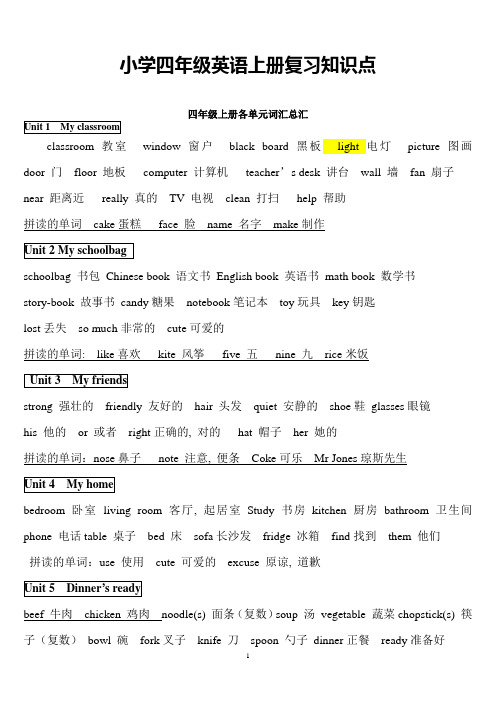
小学四年级英语上册复习知识点四年级上册各单元词汇总汇classroom 教室window 窗户black board 黑板light 电灯picture图画door 门floor 地板computer 计算机teacher’s desk 讲台wall 墙fan 扇子near 距离近really 真的TV 电视clean 打扫help 帮助拼读的单词cake蛋糕face 脸name 名字make制作schoolbag 书包Chinese book 语文书English book 英语书math book 数学书story-book 故事书candy糖果notebook笔记本toy玩具key钥匙lost丢失so much非常的cute可爱的拼读的单词: like喜欢kite 风筝five 五nine 九rice米饭strong 强壮的friendly 友好的hair 头发quiet 安静的shoe鞋glasses眼镜his 他的or 或者right正确的, 对的hat 帽子her 她的拼读的单词:nose鼻子note 注意, 便条Coke可乐Mr Jones琼斯先生bedroom 卧室living room 客厅, 起居室Study 书房kitchen 厨房bathroom 卫生间phone 电话table 桌子bed 床sofa长沙发fridge 冰箱find找到them 他们拼读的单词:use 使用cute 可爱的excuse 原谅, 道歉beef 牛肉chicken 鸡肉noodle(s) 面条(复数)soup 汤vegetable 蔬菜chopstick(s) 筷子(复数)bowl 碗fork叉子knife 刀spoon 勺子dinner正餐ready准备好help yourself 请自便pass 给, 递try 尝试拼读的单词: me 我he 他she 她we我们family 家庭parents 父母cousin表兄弟姐妹, 堂兄弟姐妹uncle 叔叔;舅舅aunt 姑姑;婶;姨baby 婴儿doctor医生cook厨师driver 司机farmer 农民nurse 护士people人们but但是little 小的puppy小狗football player足球运动员job工作basketball 篮球四年级上册各单元句型总汇We have a new classroom,.我们有一个新教室。
(word完整版)外研版小学英语六年级上册语法知识点总结,推荐文档

一、特殊疑问词及其用法二、同义句转换三、Be动词用法四、There be句型表示有……五、频率副词六、some和any的用法七、连词and和but的用法八、have got /has got的用法九、Can的用法十、询问动物是否喜欢什么句型:十一、询问别人是否经常干某事句型:Do you often…? 你经常干什么吗?十二、询问别人是否想要干某事句型:Do you want to +动词原形? 你想干什么吗?十三、选择疑问句十四、感叹句十五、强调句十六、祈使句十七、一般现在时态十八、动词各种形式的用法十九、时间的计时法二十、地点方位的表达二十一、人称代词和物主代词二十二、课文中图画所含的单词和短语二十三、模块单词短语一、特殊疑问词及其用法1. How long 问,长度(metre/kilometre)答How long is the Great Wall? It’s about six thousand seven hundred kilometers.2. How big 问,人口(people)答How big is Beijing? Beijing’s got about fourteen million people .3.How many 问,数字+名词复数答。
How many countries are in the UN? 191 countries are in the UN.4. Where问,地点/方向答Where’s New York? It’s in the east of America.5.When 问,时间答When is the UN building open? The UN building is open at 9:45.6.What time 问,钟点答。
What time is it? It’s ten to five.7. What…doing 问,动词ing答What are you doing ? I’m sending an email.8. What(is…的hobby)问,爱好答What is your hobby? Collecting stamps is my hobby./I like collecting stamps.9. What…do问,动词(事情)答。
(完整word)人教版小学英语语法知识点汇总,推荐文档

目录一、音素及音标 (2)二、音节及音节的划分 (3)三、常用字母或字母组合发音规律 (4)1、元音字母及组合的发音 (4)(1)与字母a 相关的单词 (4)(2)与字母 e 相关的单词 (5)(3)与字母i 相关的单词 (6)(4)与字母o 相关的单词 (7)(5)与字母u 相关的单词 (8)2、辅音字母及组合的发音 (9)(1)单个字母 (9)(2)字母组合 (10)四、词的变式及用法 (11)1、名词及名词的复数形式 (11)2、冠词及其用法 (12)3、代词及其用法 (13)4、形容词的比较级和最高级 (14)5、介词的固定用法 (15)五、时态及语法 (16)1、一般现在时及其用法 (16)2、现在进行时 (19)3、一般将来时 (20)4、一般过去时 (21)六、常见固定词组 (23)附各专项测试习题 (24)一、音素及音标音素:英语把组成一个读音的最小单位叫音素。
因素分为元音和辅音(相当于语文中的韵母和声母)1、元音(韵母)1.1发音方式:靠声带发音,有声调,气流通过喉头、口腔不受阻碍。
元音单元音长元音[a:][ә:][i:][ɔ:][u:]短元音[Λ][ә][i][ɔ][u][æ][e]双元音[ai][ei][ɔi][iә ][eә ][uә ][au][әu]1.3元音的结构元音的常见构成有:组合方式举例1单个元音字母D o g2元音字母+元音字母S ee、s ea、m ea t、b oo k3元音字母+辅音字母T al l、pl aya e i o u2、辅音(声母)2.1发音方式:主要是用气流与牙齿舌头等其它器官摩擦发音,气流通过喉头、口腔要受到某个部位的阻碍。
辅音10对清辅音[p] [t] [k] [f] [s] [∫][t∫][tr] [θ][ts]浊辅音[b] [d] [g] [v] [z] [ʒ][dʒ][dr] [ð] [dz] 3个鼻音[m] [n] [η]3个似拼音[h] [r] [l]2个半元音[w] [j]组合方式举例1单个辅音字母D og、b ook2辅音字母+辅音字tr ee、dr aw、tea ch、sh ip26个字母中,除去5个元音字母(a、e、i、o、u),其他字母都是辅音字母。
(完整word版)pep小学英语语法总结,推荐文档
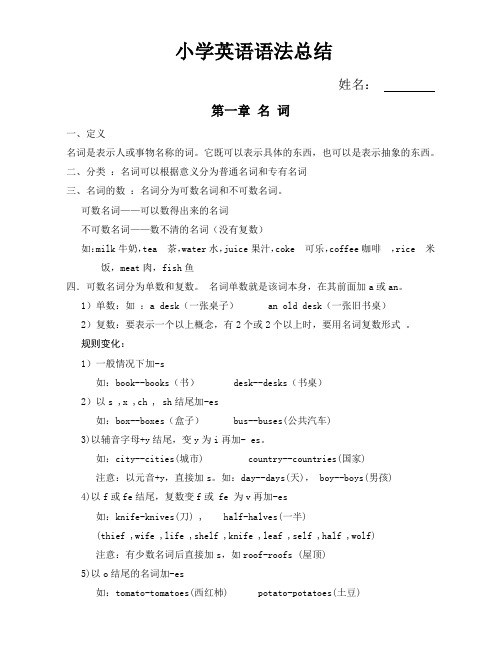
小学英语语法总结姓名:第一章名词一、定义名词是表示人或事物名称的词。
它既可以表示具体的东西,也可以是表示抽象的东西。
二、分类:名词可以根据意义分为普通名词和专有名词三、名词的数:名词分为可数名词和不可数名词。
可数名词——可以数得出来的名词不可数名词——数不清的名词(没有复数)如:milk牛奶,tea 茶,water水,juice果汁,coke 可乐,coffee咖啡,rice 米饭,meat肉,fish鱼四.可数名词分为单数和复数。
名词单数就是该词本身,在其前面加a或an。
1)单数:如:a desk(一张桌子) an old desk(一张旧书桌)2)复数:要表示一个以上概念,有2个或2个以上时,要用名词复数形式。
规则变化:1)一般情况下加-s如:book--books(书) desk--desks(书桌)2)以s ,x ,ch , sh结尾加-es如:box--boxes(盒子) bus--buses(公共汽车)3)以辅音字母+y结尾,变y为i再加- es。
如:city--cities(城市) country--countries(国家)注意:以元音+y,直接加s。
如:day--days(天), boy--boys(男孩)4)以f或fe结尾,复数变f或 fe 为v再加-es如:knife-knives(刀) , half-halves(一半)(thief ,wife ,life ,shelf ,knife ,leaf ,self ,half ,wolf) 注意:有少数名词后直接加s,如roof-roofs (屋顶)5)以o结尾的名词加-es如:tomato-tomatoes(西红杮) potato-potatoes(土豆)注意:zero 两种方式都可:zero-zeros或 zeroes(零)不规则变化1) 元音字母发变化。
如:man--men(男人) , woman--women(妇女) tooth--teeth(牙齿) ,mouse--mice(老鼠) , policeman--policemen(警察) foot--feet(脚) 2) 词尾发生变化。
PEP小学五年级英语上册知识点总结全册53页word

PEP五年级上册复习提纲Unit 1 What’s he like?old 老的,年纪大的young年轻的,岁数不大的funny滑稽的,可笑的kind 体贴的,慈祥的,宽容的strict要求严格的,严厉的polite有礼貌的,客气的shy 羞怯的,腼腆的,怕生的helpful有用的,愿意帮忙的clever聪明的,聪颖的hard-wo rking 工作努力的,辛勤的music音乐art 美术science 科学English英语maths/math 数学Chinese语文,中文sometimes 有时,间或robot机器人speak会说,会讲(某种语言);用(某种语言)说话know 知道;了解our 我们的him 他(用做宾语或表语)finish 完成;做好1.—Who’s your art teacher? 谁是你的美术老师?—Mr. Jones.琼斯老师。
2. —Is he young? 他年轻吗?—Yes, he is. 是的,他年轻。
—No, he isn’t. 不,他不年轻。
3.—What’s Wu Yifan like? 吴一帆怎样?—He’s hard-working. 他很勤奋。
4.Ms Wang will be our new Chinese teacher.王老师会成为我们的新语文老师。
5. He is very helpful at home. 他在家很能干。
6. Robin is short but strong. 罗宾个子矮,但是身体强壮。
7. He can speak C hinese andE nglish. 他会说中文和英语。
8. He make s me finish myhomework. 他让我写作业。
字母y在单词中的发音:1、双音节或多音节词末发[ i ]。
例:bab y happ y windy sunn y sorr y cand yman y famil y part y课外补充:2、y在单音节词末发[ ai ]例:b y 乘坐m y 我的wh y 为什么cr y 哭fl y 飞1、询问他人的外貌或性格:-What’s he/s he like?- He/She is kind/…2、一般疑问句的问与答:1.—Is he/she…?—Yes, he/she is.—No, he/she isn’t.2.—Do you know…?—Yes, I do.—No, I don’t3、be动词的三种形式am, is, are与人称代词连用的用法:I + am,He, she, it,人名、物名+ isWe, you, they + are识记口诀:我用am, 你用are,is用于他、她、它,所有复数都用are。
(完整word版)最新人教版(PEP)小学英语六年级上册单元知识点总结

人教版(PEP)小学英语六年级上册单元知识点Unit1 How can I get there ?一、主要单词:museum博物馆bookstore书店cinema电影院turn 转弯left向左right向右hospital医院post office 邮局science科学straight笔直地crossing十字路口二、习惯语搭配:post office邮局science museum科学博物馆pet hospital宠物医院Italian restaurant意大利餐馆Beihai Park北海公园Palace Museum故宫博物院go straight直走turn right/left右/左转next to挨着in front of...在...前面near the park在公园附近on Dongfang Street在东方大街上三、惯用表达式:Excuse me 打扰一下Follow me, please!请跟着我!四、公式化句型:1、问路的句型及其答语:问句:Where is the + 地点?···在哪儿?答语:It’s + 表示地点的词语。
它···。
next to the bookstore, near the hospital/post office, over there,on Dongfang Street, in front of the school...2、询问怎么到某地的句型及其答语:问句:How can +主语+ get (to)+地点?···怎么到···?同义句型:Can you tell me the way to +地点?Where is + 地点?Which is the way to +地点?答语:Turn +方向+表示地点的介词短语。
(完整word版)小学六年级英语词汇全

格式主格所有格宾格人称我I my me我们we our us你you your you你们you your you他he his him她she her her他们they their them 一、人称代词指示代词分类单数复数近指This( 这个 )These(这些)远指That (那个)Those(那些)二、指示代词三、疑问代词疑问代词用法说明例句who常用于提问人的姓名、身份Who ’s she? what常用于问事物或某人的活动What ’s you father? where常用于问地址,意为“在哪里Where do you live? whose是 who 的所有格形式Whose bike is this?which在必然范围内的特指人活物Which do you like?how常用于问情况“怎么样How tall are you?how many常用于问数量是“多少”How many books are here? how much常用于问价钱是“多少”How much is this bed? How about常用于问别人的感觉“好不好” How about going to school? how old用于问年纪How old is your mother?四、不定代词代替或修代替或修用法说明例句饰可数名饰不可以数词名词some一般用于必然句I have some bookany 一般用于否定句、疑问句I don’t haveany book.Do you have any book?many much 用于修饰表示好多的可数He has much money,but he /不可以数名词doesn’thave many friend.日期英文写法周一Mondy周二Tuesday周三Wednesday周四Thursday周五Friday周六Saturday周日Sunday天day周末weekend教师节Teacher’s Day五、数字和日期一one二two三three四four五five六six七seven八eight九nine十ten十一eleven十二twelve十三thirteen十四fourteen十五fifteen十六sixteen十七seventeen十八eighteen十九nineteen二十twenty 二十一twenty-one 三十thirty三十一thirty-one四十forty五十fifty六十sixty七十seventy八十eighty九十ninety百hundred第一first第二second第三third 各种语法单词齐集元旦New Year国庆节National Day一月Jan./January二月Feb./February三月Mar./March各种语法单词齐集Apr./April四月五月May六月June七月July六、动词三种形态八月Aug./Augest九月Sept./September十月Oct./October十一月Nov./November十二月Dec./December春天Spring夏天Summer秋天Fall冬天Winter动词现在进行时一般现在时 (第三过去式人称单数 )Buy 买buying buys baught Clean 打扫cleaning cleans cleaned Drive 开车driving drives drivedGo 去going goes goneDo 做doing does done Have 有having has had Close 关closing closes closed动词现在进行时(现一般现在时 (第三过去式 (过去分词 )在分词)人称单数 )Open 开opening opens opened Find 搜寻finding finds foundLive 活,住living lives livedRead 阅读reading reads read Swim 游泳swimming swims swam Sing 唱歌singing sings sang Ride 骑车riding rides rode Take 买,带taking takes took Put 放putting puts putStop 停止stpping stops stoped Run 跑步running runs ranWait 等待waiting waits waited Look 看looking looks looked Wash 洗washing washes washed Watch 看(电视)watching watches watched Wear 穿(衣服)wearing wears worn Write 写字writing writes wrote六年级英语语法知识汇总一、词类:1、动词:行为动词、be动词、神情动词。
(完整版)小学英语1-6年级要点知识点汇总(期末特别整理)

小学英语1-6年级要点知识点汇总(期末特别整理)第一部分:基础知识2. 以s. x. sh. ch 结尾,加-es ,如:bus-buses,1. 字母:26 个字母的大小写box-boxes, brush-brushes, watch -watchesABCDEFGHIJKLMNOPQRSTUVWXYZ 3.以“辅音字母+y” 结尾,变y 为i, 再加-es ,abcdefghijklmnopqrstuvwxyz 如:family-families, strawberry -strawberries2.语音:元音的发音 4.以“ f或fe ”结尾,变f或fe为v,再加-es , 五个元音字母:AEIOU 如: knife-knives12个单元音:前元音:[i:] [ ?] /e/ [?] 5.不规则名词复数:中元音:[?:] [ ?] man-men, woman-women, policeman -policemen,后元音:[a :] [ ?] [ ?:] [u :] [ ?] [ ?] policewoman -policewomen, mouse -mice双元音(8个)child -children, foot-feet, tooth-teeth,I .合口双元音(5个)fish-fish, people-people, Chinese -Chinese, [ai] [ei] [au] [ ?u] [ ?i] Japanese -Japanesen.集中双元音(3个)[i ?][ £ ?][u ?] 不可数名词的复数就是原型:paper, juice,3.词汇:词汇量,近反义词water, milk, rice, tea4.句子:大小写,标点符号(二)名词的格第二部分:语法知识(1)有生命的东西的名词所有格:一.名词:名词单复数,名词的格a)单数后加's如:Lucy ' s ruler my(一)名词单复数father ' s shirt1. 一般情况,直接加-s ,如:book-books, b)以s结尾的复数名词后加'如:hisbag-bags, cat-cats, bed-beds friends ' bagsc) 不以s结尾的复数后加's children ' s shoesI并列名词中,如果把’s加在最后一个名词后,表示共有,如:Tom and Mike' s car 汤姆和迈克共有的小汽车I要表示所有物不是共有的,应分别在并列名词后加’sTom s and Mike ' s ca rs 汤姆和麦克各白的小汽车(2) 表示无生命东西的名词通常用“ of +名词来表示所有关系:如:a picture of the classroom a map of China 第二部分:语法知识二. 冠词:不定冠词,定冠词种类:(1) 不定冠词:a / an a unit / an uncle 元音开头的可数名词前用an :an egg / an apple / an orange / an eraserI an answer / an ID card / an alarm clock / an actor / an actress / an e -mail / an address /an event / an example / an opera / an houran old man / an interesting book / an exciting sport / an action movie / an a rt lesson /(2) 定冠词:the the egg the plane2. 用法:定冠词的用法:(1) 特指某(些)人或某(些)物:The ruler is on the desk.(2) 复述上文提到的人或物:He has a sweater.The sweater is new.(3) 谈话双方都知道的人或物:The boys aren ' t at school.(4) 在序数词前:John" s birthday is February the second.(5) 用于固定词组中:in the morning / afternoon / evening不用冠词的情况:(1) 专有名词前:China is a big country.(2) 名词前有定语:this , that, my , your, some, any , no 等:This is my baseball.(3) 复数名词表示一类人和事:Monkeys can" t swim. They are teachers.(4) 在节日,日期,月份,季节前:Today is Christmas Day. It ' s Sunday.(5) 一日三餐前:We have breakfast at 6:30.(6)球类棋类运动前:They often play football after class. He plays chess at home.*但乐器前要用定冠词:I play the guitar very well.(7)学科名称前:My favorite subject is music.(8)在称呼或头衔的名词前:This is Mr Li.(9)固定词组中:at noon at night by bus第二部分:语法知识三、代词、形容词、副词代词:人称代词,物主代词人称代词物主代词主格宾格第一人称单数1(我)memy(我的)复数we(我们)usour(我们的)第二人称单数you(你)youyour(你的)复数you(你们)youyour(你们的)第三人称单数he (他)himhis(他的) she(她)herher(她的)it(它)itits(它的)复数they(他们/她们/它们)themtheir(他们的/她们的/它们的)形容词,副词:比较级,最高级(一)、形容词的比较级1. 形容词比较级在句子中的运用:两个事物或人的比较用比较级,比较级后面一般带有单词than。
(word完整版)小学英语语法总结大全,推荐文档

小学英语语法大全第一章名词一、定义名词是表示人或事物名称的词。
它既可以表示具体的东西,也可以是表示抽象的东西。
二、分类1.名词可以根据意义分为普通名词和专有名词如:John is a student student是普通名词,John是专有名词普通名词前可以用不定冠词a/an,定冠词the或不加冠词,专有名词前一般不加冠词,专有名词的首字母要大写。
2.普通名词又可以分为个体名词、集体名词、物质名词和抽象名词,其中个体名词与集体名词是可数名词,物质名词和抽象名称是不可数名词。
3.专有名词专有名词是表示人名、地名、团体、机构、组织等的专有名词,多为独一无二的事物。
三、名词的数1、名词分为可数名词和不可数名词。
可数名词——可以数的名词不可数名词——数不清(没有复数)drink milk tea water orange juice coke coffee porridge food rice bread meat fish fruit cake dumplings2、可数名词与不定冠词a(an)连用有数数形式,不可数名词不能与不定冠词a(an)连用,没有复数形式many+可数名词复数much/ a little+不可数名词some, any, a lot of (lots of)两者都可以修饰。
3、可数名词可以直接用数词来修饰不可数名词数词+量词+of+名词对可数名词的数量提问用how many对不可数名词的数量提问用how much4、不可数名词的量有以下两种表示方法:1)some, much, a little, a lot of, a bit of, plenty of用等表示多少。
注意既可以与可数名词复数,又可以与不可数名词连用的有:plenty of, some, a lot of, lots of, most of等。
如there is much water in the bottle.瓶中有很多水。
(完整word)pep小学五年级英语Unit4知识点总结,推荐文档
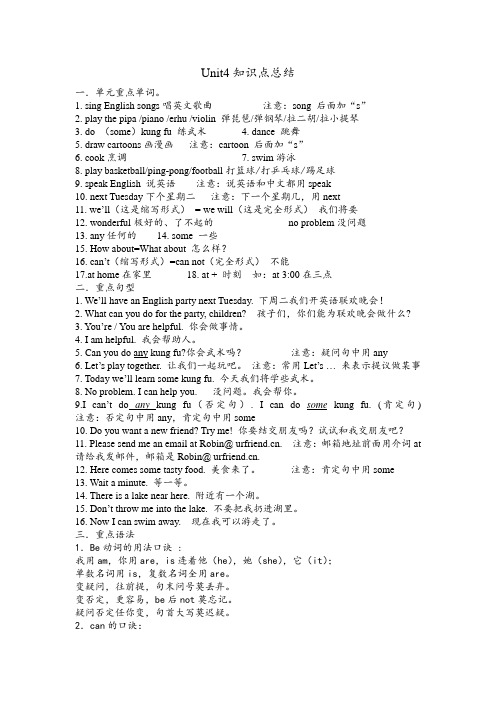
Unit4知识点总结一.单元重点单词。
1. sing English songs唱英文歌曲注意:song 后面加“s”2. play the pipa /piano /erhu /violin 弹琵琶/弹钢琴/拉二胡/拉小提琴3. do (some)kung fu 练武术4. dance 跳舞5. draw cartoons画漫画注意:cartoon 后面加“s”6. cook烹调7. swim游泳8. play basketball/ping-pong/football打篮球/打乒乓球/踢足球9. speak English 说英语注意:说英语和中文都用speak10. next Tuesday下个星期二注意:下一个星期几,用next11. we’ll(这是缩写形式)= we will(这是完全形式)我们将要12. wonderful极好的、了不起的no problem没问题13. any任何的14. some 一些15. How about=What about 怎么样?16. can’t(缩写形式)=can not(完全形式)不能17.at home在家里18. at + 时刻如:at 3:00在三点二.重点句型1. We’ll have an English party next Tuesday. 下周二我们开英语联欢晚会!2. What can you do for the party, children? 孩子们,你们能为联欢晚会做什么?3. You’re / You are helpful. 你会做事情。
4. I am helpful. 我会帮助人。
5. Can you do any kung fu?你会武术吗?注意:疑问句中用any6. Let’s play together. 让我们一起玩吧。
注意:常用Let’s …来表示提议做某事7. Today we’ll learn some kung fu. 今天我们将学些武术。
- 1、下载文档前请自行甄别文档内容的完整性,平台不提供额外的编辑、内容补充、找答案等附加服务。
- 2、"仅部分预览"的文档,不可在线预览部分如存在完整性等问题,可反馈申请退款(可完整预览的文档不适用该条件!)。
- 3、如文档侵犯您的权益,请联系客服反馈,我们会尽快为您处理(人工客服工作时间:9:00-18:30)。
小学三年级英语(上册)重要知识点归纳一、单词Unit 1学习文具:pen (钢笔) pencil (铅笔) pencil-case ( 铅笔盒) ruler(尺子) eraser(橡皮) crayon (蜡笔) book (书) bag (书包) sharpener (卷笔刀) school (学校) Unit 2身体部位:head (头) face( 脸) nose (鼻子) mouth (嘴) eye (眼睛) leg (腿) ear (耳朵) arm (胳膊) finger (手指) leg (腿) foot (脚) body (身体)Unit 3颜色:red (红色的) yellow (黄色的) green (绿色的) blue (蓝色的) purple (紫色的) white (白色的) black (黑色的) orange (橙色的) pink (粉色的) brown (棕色的) Unit 4动物:cat (猫) dog (狗) monkey (猴子) panda (熊猫) rabbit( 兔子) duck (鸭子) pig (猪) bird (鸟) bear (熊) elephant (大象) mouse (老鼠) squirrel (松鼠)Unit 5食物:cake (蛋糕) bread (面包) hot dog (热狗) hamburger (汉堡包) chicken (鸡肉) French fries (炸薯条) coke (可乐) juice (果汁) milk (牛奶) water (水) tea (茶) coffee (咖啡)Unit 6数字:one (一) two (二) three (三) four (四) five (五) six( 六) seven (七) eight (八) nine( 九) ten( 十) doll (玩具娃娃) boat (小船) ball (球) kite (风筝) balloon (气球)car (小汽车) plane (飞机)二.、对话1、向别人问好应该说――A: Hello! (你好!)B: Hi! (你好!)2、问别人的名字应该说-――A:What's your name? 你的名字是什么? B:My name's Chen Jie. 我的名字是陈洁。
3、跟别人分手应该说――A: Bye.\ Good bye!(再见)B: See you.(再见) \ Goodbye.(再见)4、A: I have a pencil\ bag\ruler 我有一只铅笔\书包\尺子。
B: Me too . 我也有。
5、早上相见应该说-――A: Good morning. 早上好!B: Good morning! 早上好!6、下午相见应该说――A: Good afternoon! 下午好!B: Good afternoon! 下午好!7、跟新朋友第一次见面――A: Nice to meet you! 见到你很高兴。
B: Nice to meet you,too! 见到你也很高兴!8、A: Let's go to school! 让我们一起去上学!B: OK! 好的。
9、看见久未见面的朋友或者别人身体不舒服,你该这么打招呼-A: How are you ? 你好吗?B: Fine,thank you我很好,谢谢你。
10、A: Let's paint. 让我们画画。
B: Great! 棒极了!11、A: Look I have a rabbit\monkey. 看,我有一只兔子\猴子。
B: Cool\Super \ Great \ Wow! 酷\超级好\棒极了\好厉害.12、你想看下别人的东西,你该这么说――A: May I have a look? 我可以看一看吗?B: Sure. Here you are! 当然可以。
给你!13、请别人吃东西,你该这么说――A: Have some French fries. 吃一些炸薯条。
B: Thank you.\ No, thanks. 谢谢你。
\不,谢谢你。
14、A: What do you like? 你喜欢什么?B: I like hot dogs. 我喜欢热狗。
15、你想吃点东西,你该说――A: Can I have some chicken? 我能吃一些鸡肉?B: Sure here you are. 当然可以,给你。
16、A: Thank you. 谢谢你。
B: You're welcome. 别客气。
17、A:B: Happy birthday. 生日快乐!B: Thank you. 谢谢。
18、A: How old are you? 你几岁啦?B: I'm nine. 我九岁了。
(要用数字回答哦!)19、A: Let's eat the birthday cake. 让我们吃生日蛋糕B: Great! 棒极了!20、A: How many balloons\ gifts? 多少个气球\礼物?B: Four \ ten. 四/十。
三、句子Unit 1--1.show me your pencil / ruler/ eraser/ crayon/ pen. 让我看看你的铅笔/尺子/橡皮/蜡笔/钢笔。
2. open your pencil--case. 打开你的铅笔盒。
close your book .合上你的书。
show me your sharpener. 让我看看你的卷笔刀。
carry your bag. 背起你的书包。
go to school . 去上学。
Unit 2. 3 Touch your head./ nose/ eye/ mouth/ ear. 摸摸你的头/鼻子/眼睛/嘴巴/耳朵。
4. Clap your hands. 拍拍你的手。
Snap your fingers. 打响你的手指。
Wave your arms. 挥挥动你的胳膊。
Cross your legs. 翘翘你的双腿。
Shake your body. 扭扭你的身体。
Stamp your foot. 跺跺你的脚。
Unit 3. 5.Show me your red/ blue / green / yellow / purple crayon.给我看看你的红/蓝/绿/黄/紫色蜡笔。
6.Black, black. Stand up. 黑色,黑色,站起来(起立)!Pink , pink. Sit down. 粉红色,粉红色,坐下!Brown, brown. Touch the ground. 棕色,棕色,摸摸地板。
Orange, orange. Touch your head. 橙色,橙色,摸摸你的头。
White, white. Turn around. 白色,白色,转个圈。
Unit4.7. Act like a cat/ duck/ panda/ monkey/ rabbit/ dog. 模仿小猫/鸭子/熊猫/猴子/兔子/小狗表演。
8. Hunt like a mouse. 像老鼠一样搜寻。
Walk like a elephant. 像大象一样走路。
Climb like a bear. 像狗熊一样爬。
Fly like a bird. 像小鸟一样飞。
Jump like a squirrel. 像松鼠一样跳。
Unit5.9 .Show me your hamburger. 让我看看你的汉堡包。
Pass me the French fries. 把炸薯条递给我。
Cut the bread. 切面包。
Eat the hot dog. 吃热狗。
Smell the chicken. 闻闻鸡肉。
Make the cake. 做蛋糕。
10. pour the water 倒水。
Smell the coffee 闻闻咖啡。
Taste the tea 尝尝茶。
Show me the milk 让我看看牛奶。
Drink the juice 喝果汁。
11. bounce the ball.拍拍球。
fly the kite. 放风筝。
throw the plane.扔出飞机。
hold the doll.抱娃娃。
Drive the car.开车。
blow up the balloons.吹气球。
六年级上册Unit 1 How do you go to school?一、重点短语:by plane 坐飞机by ship 坐轮船on foot步行by bike 骑自行车by bus 坐公共汽车by train 坐火车traffic lights 交通灯traffic rules交通规则go to school 去上学get to 到达get on上车get off下车Stop at a red light. 红灯停Wait at a yellow light. 黄灯等Go at a green light. 绿灯行二、重点句型:1.How do you go to school?你怎么去上学?ually I go to school on foot. Sometimes I go by bus.通常我步行去上学。
有时候骑自行车去。
3.How can I get to Zhongshan Park ?我怎么到达中山公园?4.You can go by the No. 15 bus. 你可以坐15路公共汽车去。
三、重点语法:1、There are many ways to go somewhere.到一个地方去有许多方法。
这里的ways一定要用复数。
因为there are是There be句型的复数形式。
2、on foot 步行乘坐其他交通工具大都可以用介词by…,但是步行只能用介词on 。
4、go to school的前面绝对不能加the,这里是固定搭配。
5、USA 和US 都是美国的意思。
另外America也是美国的意思。
6、go to the park 前面一定要加the. 如果要去的地方有具体的名字,就不能再加the ,如果要去的地方没有具体名字,都要在前面加the. (go to school除外。
)7、H ow do you go to …?你怎样到达某个地方?如果要问的是第三人称单数,则要用:How does he/she…go to …?8、反义词:get on(上车)---get off(下车)near(近的)—far(远的)fast(快的)—slow(慢的)because(因为)—why(为什么)same(相同的)—different(不同的)9、近义词:see you---goodbye sure---certainly---of course10、频度副词:always 总是,一直usually 通常often经常sometimes 有时候never 从来不Unit 2 Where is the science museum?一、重点短语:library 图书馆post office 邮局hospital医院cinema 电影院bookstore书店science museum科学博物馆turn left向左转turn right 向右转go straight 直行north北south南east东west西next to靠近、与……。
